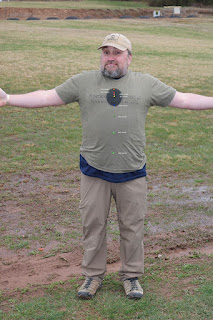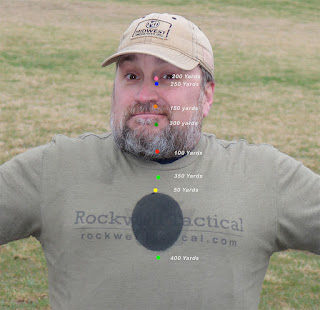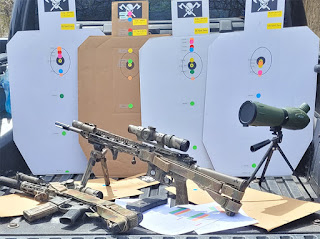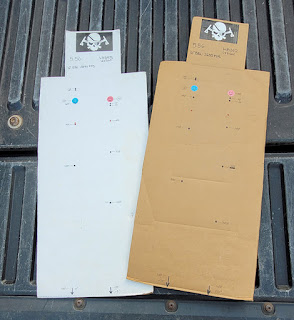Garry: “Hey bro, your rifle is totally not zeroed. You didn’t read the gear list?” Student: “Oh, it’s zeroed.” Garry: “Dude, you’re more than a foot low” Student: “Well yeah, at 50 yards. It’s not zeroed for 50 yards.” Garry “I know.” Student:.... Garry:.... Student:.... Garry: “What distance is it zeroed at?” Student: “7 yards, the average distance for shootings” Garry:.... Student: “What?” Garry: “Can you see people at 300 yards?” Student: “uh, yeah.” Garry: “ What’s your hold for that distance?” Student: “I dunno.” Garry “Me either.”
That's a true interaction from a basic carbine class I was teaching for a former employer. I had to bust out a calculator to get him his answer because that's not the kind of info I would ever memorize. I’m not going to disclose what department this fella worked for as to save them the embarrassment, but this was from someone whose profession was to carry a gun.
Now there’s not a lot of reason to rehash another article about the different zero options out there. Most of the time, it’s either somebody trying to reinvent the wheel so they have something to attach their name to ( The 77.25 Meter zero anybody?) or it’s simply someone looking for content and they nearly plagiarize someone else’s article. The only thing we really do differently than most at classes is the diagrams we use show where hits would be on a target at those different ranges as opposed to those side-view diagrams of a giant arc. We found that it’s a better learning experience for a student to see the result than a graphic rendition of the flight path.

I snagged this from a class I took. An SOF instructor called this bush-league drawing a proper training aid.
I learned this trick from a former coworker. He had made up a few of these for his old unit and would show them to civilian students. I had asked him once if he had something other than 62Grain (M855) out of a 14.5” barrel (~2800FPS) as this is far from the most common combination we see at class. He didn’t, so I set about making one. I had to borrow a chronograph to get some velocity data and shot some various weight ammo out of my Midwest Industries Recce Rifle with it’s 16” barrel. Once I had this data, I used a free online ballistic calculator to get some figures. Now here’s where we get some divergence from the data and real life. There are some things in those calculators that can be adjusted, but real life has more things going on than a free calculator has parameters for. So the data represents what happens in the bullets flight path extremely well, you probably won't get the same numbers if you try to recreate it on the range. The velocity is wildly affected by brand, line and lot of ammo. I ran Federal American Eagle for the 55 Grain,Lake City for the 62 grain, Black Hills for the 77 and Wolf for the 7.62 x39 out of my AK (Romanian kit). Switch to a different brand and you are going to see different velocities. Obviously, your barrel will yield different velocities and we’re not even taking into account any atmospheric considerations. But the point remains valid even if the real word numbers will vary.
Sometime this summer we’re going to make a video showing this performed at the range and most likely with different ammo than I used to get velocity data from and while we will see different numbers, the poa/poi ratios will be strikingly similar so these cardboard aides we bring to class still tell the moral of the story.
When talking about zero’s, the reality is that your ability to use the zero is vastly more important than whatever zero option you choose. If you instinctively know your holdovers for various distances and then the second critical part, and that is knowing what range your target is at. This is where most folks fail. The ability to look at a dude and accurately tell the distance is not a skill many shooters excel at. The further away, the less accurate people are at rangefinding and also the more critical it is for us to be accurate in our estimation.
 |
| How far away is this dude in each of the photos? |
I prefer to recommend that shooters use a zero that requires the fewest known holdovers as that allows them to just put the dot on the heart of the bad guy without having to be as precise on the range estimation. Here are some photos of a dude at various ranges out to 400 yards. For a lot of folks, that's about as far as they are going to see a dude without some level of magnification. If we’re using a magnified optic, such as an LPVO, the reticle is likely designed around a certain zero distance so we’re going to stick to non-magnified optics out to 400 yards.
What I thought I would do a little different for this article was instead of using an old cardboard target marked up accordingly, I’d use a photo of a dude. The targets are easy to read and are cut down to fit in a pelican case along with a rifle while flying to classes, but this is the interwebs and we can pull off a little more with technology so we’re going photo realistic.
For a point of aim, I used the heart. As opposed to a brain shot, the heart has much larger room for error and with a non-magnified optic. At some of these ranges, aiming for the brain box wouldn't be ideal, and for some it would be an unobtainable result. For the main description, We using that Federal 55grain ammo, out of a 16” barrel. I’ll include the data and photos for 62 and 77 as well. The spread will be different but the point is still the same. Were going to aim at the same spot on the badguy so the POA is no longer a variable. With a chosen zero, we will see where hits are (POI) at various ranges without moving the point of aim (POA). Well try out the 3 most common zero distances, but before we do, let's bust a couple of myths. 50/200 is not. Maybe with some weight bullet out of some length barrel is, but I can't recreate that with anything I own. 50 is very common, but it’s not 200. The next is the 25/300. That one is a farce of grand scale. It’s not remotely close to being the same at 300 as it is at 25, you’ll see. I don't consider a 25 yard zero a real zero so we’ll include it but as an afterthought not to be considered as an actual option for zero distance.
 |
| 100Yard POI |
Let's take a look at the 100 yard zero. It’s the most common zero distance I see with newer shooters. Our point of aim is the same, center of the heart. Like all choices, we are 2.5” low at point blank. Which leaves us with a solid hit in the heart. At 50, we’re 1.25” low and obviously at 100 we are dead on (pun intended). Out to 200 we’re about 2” low, which is a great hit in the old pump. Here’s where it starts to fall off. By 250 yards, we’re below the heart and have a better chance of hitting the less critical organs than the descending Aorta. By 300, yards we’re getting gut shots. Not a great location for making hits and then we multiply that by how bullets perform with their terminal ballistics (what they do inside the body) and we have fallen out of a desirable hit.
 |
| 50Yard POI |
When we switch to the 50 Yard Zero, which is the most common that I see from more experienced shooters. We obviously have the same point-blank distance, and at 50 we are dead on (same pun, it’s just less funny now). At 100, we’re an inch and half high, which is still in the heart, and at 150, we get up to about 2” high, also still in the heart. As we stretch out to 200 yards, we find our hits an inch low, which is still a great heart hit. We don't drop to the 5” low region until 300 yards. We essentially bought ourselves another 50 yards of distance for hitting a human heart without holding any differently.
 |
| 36 Yard POI |
The newest one that I have seen is the 36 yard zero. I really don't see it often, but I do see it enough to talk about it. By now you know what the point-blank result is (2.5” low) and were making perfect hits at 36. At 50 we’re an inch high and right in the good part of the heart. By 100 we’re right at the sternal notch. Thats gonna end a badguys day as long as you’re windage is perfect. Once we get into neck hits, our chances of missing greatly increase since the neck is very thin compared to the torso. That's why we picked the heart as an aiming point. Even if we hook or slice the shot, we still hit some important body parts. By 150 yards we’re up top the Adams apple and we really need to start considering a holdunder. This of course is completely doable if you are aware of how low to hold and can rapidly estimate the difference of a bad guy between 100-150 yards. We don't get drop down to that 5”(ish) low mark until 350 yards. Essentially buying another 50 yards of distance without using a holdover but at the cost of needing a holdunder in the 100-150 yard ranges.
Now out on the outside edge at 400 yards, where it is getting harder to see our bad guy, these three distances do have some significant differences. That 100-yard zero has us hitting a bad guy in the thigh. The 50-yard zero will be impacting in the belly and the 36 will be in the intestines. The thing to factor when deciding which zero is what sacrifices are made for what gains. None of those three are wrong, they just have different strengths and weaknesses. And then the hard part starts, learning to rapidly make precision hits at varying ranges with the zero that you chose.
 |
| 25 Yard zero is stupid! Don't Fucking do this! |
By the way, the answer for that officer? 76” low is his holdunder. So yeah, he’d need to aim 6 feet low to make that hit.



No comments:
Post a Comment
Thanks for sharing.